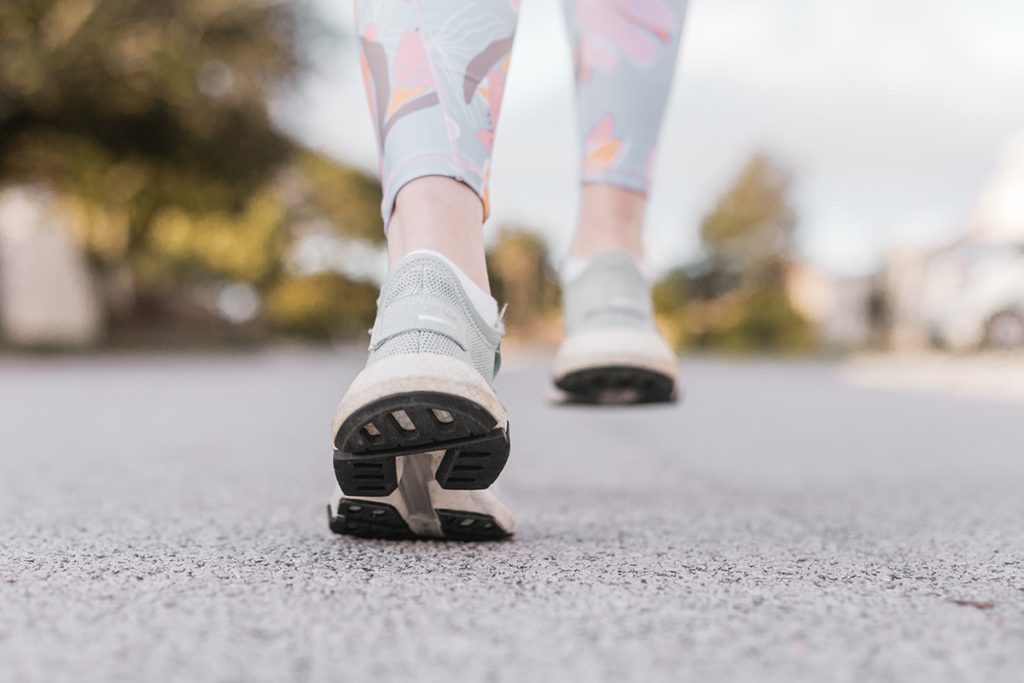
If ease of walking is keeping you from certain activities, Bobbie Kayser, a physical therapist with Frazier Rehab, says the best first step is to check in with your physician. Whether you experience unsteadiness, weakness, or pain, Kayser says a doctor visit “will save a lot of time to really find out what the issue is.” Depending on your diagnosis, some of the following items might make your mobility easier and more comfortable.
If you are shopping or sightseeing. . .
Try some stylishly well-made shoes, like Clarks, Merrell, or Dansko.
Why they work: These brands have a reputation for being good-looking and extremely comfortable. Clarks has a line called Cloudsteppers, which are flexible and lightweight for easier movement. Dansko shoes cushion the feet so well that they are sought after by professionals who are standing or walking all day long. My own pair of much-loved Merrell shoes is as comfortable now as when I bought them over a decade ago.
Cost: Depending on the style and whether they are for men or women, these brands typically run from $65-$125.
Where to buy: These shoe brands can be found at department stores and online. Cardinal Uniforms & Scrubs and other local medical uniform shops keep Dansko in stock.
Level of durability: While these shoes aren’t cheap, they last forever and look good the entire time.
Pros: Many of these shoe brands carry styles that can work for both casual and dressy events. You might pay a little more, but you won’t have to change shoes after running errands to head to church or dinner at a restaurant.
Cons: If the style you want isn’t carried locally, you may have to order online and deal with trying on shoes at home and shipping back the sizes that don’t fit.
If you have foot pain . . . try orthotic inserts.
Why they work: Custom-made orthotics are made to your exact specifications and allow you to wear a wide range of shoes. Over-the-counter orthotics like PowerSteps or Dr. Scholl’s can be a good first step if you want to try orthotics before scheduling a custom consultation.
Cost: Dr. Scholl’s P.R.O. Pain Relief Orthotic and many others can be found at online retailers for around $10. Custom orthotics could run into the hundreds of dollars depending on the severity of your foot issues.
Where to buy: Over-the-counter orthotics are sold at grocery and drug stores, as well as online. To speak to someone in person about orthotics, including the possibility of a custom-made pair, you might consider making a visit to The Good Feet Store or a medical supply shop.
Level of durability: Custom orthotics will generally last years, while over-the-counter options may last months.
Pros: Orthotics can be placed inside many different styles of shoes that you already own.
Cons: In order for orthotics to work, you have to remember to put them in your shoes. If you use over-the-counter brands, you need to change them more frequently.
If you tire quickly, are unsteady on your feet, or have knee pain . . . try a rollator
Why it works: A rollator is a rolling walker and seat in one. It provides stability to help you be mobile, but it also allows you to stop as needed, sit, and catch a breath or relieve pressure on your legs.
Cost: Rollators start at around $100 and increase in price depending on special features.
Where to buy: Medical equipment stores such as Cooley’s and Gould’s stock rollators, but you can also purchase online.
Level of durability: These items are built to be long-lasting and stable.
Pros: A rollator will allow you to be mobile as much as you are able and have the comfort of knowing you can rest as needed.
Cons: Depending on its size, your strength, and where you plan to use it, a rollator could become unwieldy or an obstacle. The last thing you want is to have a mobility item that you fall into or over.
Simple Exercises to Improve Mobility
Frazier Rehab physical therapist Bobbie Kayser recommends standing at the kitchen counter to do these exercises since it is the perfect height and provides stability.
- Marching in place
- Leg lifts out to the side
- Leg lifts to the back
Kayser says these simple exercises should be done in a slow and controlled fashion. “They are all inherently balance activities that work the core, trunk, and lower extremities and help improve stability which, in turn, facilitates mobility,” she adds.
By Carrie Vittitoe
Leave a Reply